#there is a super cool cover
Explore tagged Tumblr posts
Text


The Intersectionality of Queer Identity & Punk Rock
A Zine?
Yes, zine! Zines are like little pockets of subculture just waiting to be discovered. For me, they've been a constant source of fascination since my middle school emo days, when I first read Perks of Being a Wallflower. It was like finding a secret language, a way to express myself outside the mainstream. The Rocky Horror Picture Show and alternative music were my jam back then (and still are!) and discovering that zines could blend both worlds was utterly mind-blowing.
I delved deep into zine archives, soaking up inspiration from creators who came before me. I researched tirelessly, learning the ins and outs of zine-making, and honing my writing skills for the chance to contribute my own voice to this brilliant community. Suddenly, I had this platform where I could talk about everything I loved in one place. It wasn't just about sharing passions; it was about connecting with others who felt the same way, building a community of like-minded souls bound together by ink and paper. It was liberating!
Why did I choose this mode?
As stated before, zines bring together important conversations that people are passionate about. I am pulling from Perks of Being a Wallflower in the sense that I am bridging two concepts that are very close to my heart. As an as a self-described alternative queer man, I believe it is very important to remember where we came from, who came before us. This zine serves as an homage to the queer/alternative voices that came before me; however, this is not just for other queer or alternative individuals. This is for everyone. Regardless of politics, identity, or location, this zine is for you.
Where does Zine culture come from?
Zine culture, with its raw, unfiltered expression and grassroots ethos, finds its roots intertwined with the rise of punk music in the mid-1970s but can be traced all the way back to the early 1930s. Emerging as a response to the commercialization and homogenization of mainstream media, zines served as DIY platforms for individuals to share their thoughts, ideas, and creations in a tangible, accessible format.[x]
The DIY ethos embedded within zine culture finds its parallel in the punk movement. While previous musical genres such as skiffle and rock and roll also embraced DIY elements, it was punk that elevated the concept to a central tenet of its cultural and musical identity.[x] Punk rejected the polished, corporate-driven sound of mainstream music in favor of a raw, do-it-yourself approach that prioritized authenticity and individuality over commercial success.
In the face of state intervention and commercialization within the music industry, participants in alternative music scenes often embraced DIY as a form of resistance. By creating and disseminating their own zines, bands, artists, and activists asserted their independence from mainstream institutions and asserted their right to self-expression. This resistance was not merely a rejection of external forces but also a reclaiming of cultural autonomy and a celebration of DIY values.
Zine culture, therefore, emerges as a direct response to the limitations and shortcomings of mainstream media and culture. It represents a space where creativity knows no bounds, where voices that are often marginalized or silenced can find resonance and solidarity. In its simplicity and accessibility, zine culture embodies the spirit of punk's DIY ethic, offering a platform for self-expression and community-building that continues to thrive and evolve in the digital age.
Why are zines important?
Zines are vital conduits for self-expression, community building, and the preservation of alternative voices. Rooted in a rich history of resistance and creativity, zines offer a platform for individuals to share their thoughts, ideas, and creations outside the constraints of mainstream media. Emerging as a response to the homogenization and commercialization of traditional publishing, zines embody a rebellious spirit that champions authenticity and individuality.
Unlike glossy, corporate publications, zines are often cheaply made and readily accessible, democratizing the process of expression and inviting participation from individuals of all backgrounds. This accessibility not only empowers creators to share their stories but also fosters a sense of connection and camaraderie among like-minded individuals who share common interests and passions.
At its core, zine culture is about more than just printing; it's about building community and amplifying marginalized voices. By creating and sharing zines, creators forge connections with readers, sparking conversations and collaborations that transcend geographical boundaries. Zines serve as historical and cultural artifacts, documenting the experiences and perspectives of diverse communities, ensuring that alternative narratives are preserved and celebrated. In a world where mainstream media often overlooks or silences marginalized voices, zines offer a space for these voices to be heard, valued, and embraced.
The Basics
A subculture refers to a distinct group within a larger society that shares a set of beliefs, values, practices, and interests that deviate from mainstream culture. Subcultures are born out of a variety of social, cultural, and historical factors, often as a response to the perceived limitations or inadequacies of mainstream society. Dissatisfaction with societal norms and values can lead individuals or groups to seek out alternative spaces where they can express themselves authentically and find like-minded peers.
Subcultural groups often draw inspiration from existing cultural forms, such as music, fashion, art, and literature, which they reinterpret and repurpose to reflect their own distinct identities and sensibilities. This process of reclamation allows subcultures to create new meanings and symbols that resonate with their members, contributing to the evolution and diversification of subcultural identities.
Why punk?
In "Visual Vitriol" by David A. Ensminger, the author encapsulates the essence of punk rock as a refuge for those seeking a space to express themselves authentically. He reflects on the allure of punk, suggesting that many are drawn to it for the opportunity it provides to embrace a queer or unconventional identity comfortably. The quote from "INSIDE FRONT #13" captures this sentiment, highlighting punk as a haven for those who feel alienated from mainstream culture, offering a platform for self-expression without judgment.
Ensminger also acknowledges the significant influence of the LGBTQ+ community within punk. He asserts that "Gays shaped both the looks typifying punk and the history of punk music," recognizing the pivotal role of LGBTQ+ individuals in defining punk's aesthetic and its evolution as a cultural movement. This acknowledgment underscores the profound impact of queer individuals on the visual and musical elements that have become synonymous with punk. In essence, Ensminger's summary portrays punk not only as a musical genre but also as a cultural space shaped by and for those who seek to challenge societal norms and celebrate their identities openly.[x]
Punk 101
Punk rock emerged in the mid-1970s as a raw, energetic, and rebellious response to the perceived stagnation and commercialization of mainstream rock music. Its roots can be traced back to earlier musical movements such as garage rock, protopunk, and glam rock, which laid the groundwork for the aggressive, stripped-down sound that would later define punk. Bands like The Velvet Underground, The Stooges, MC5, and New York Dolls contributed to the development of this new musical aesthetic, characterized by its simplicity, urgency, and confrontational lyrics.
The early punk scene in New York City, centered around clubs like CBGB and Max's Kansas City, saw the emergence of pioneering bands like Ramones, Blondie, Talking Heads, and Patti Smith. These artists rejected the polished, virtuosic style of mainstream rock in favor of a do-it-yourself (DIY) ethos and a more direct, unfiltered approach to music. Meanwhile, across the Atlantic, a parallel punk movement was taking shape in the United Kingdom, spearheaded by bands like Sex Pistols, The Clash, The Damned, and Buzzcocks. Fuelled by a sense of disillusionment with the social and political climate of the time, UK punk bands captured the attention of disaffected youth with their raw energy and provocative lyrics.
Ensminger’s analysis that highlights the significant influence of the LGBTQ+ community within punk, recognizing their pivotal role in shaping the genre's aesthetic and cultural evolution. Punk provided a refuge for those seeking to express themselves authentically, including queer and unconventional identities. This acknowledgment underscores punk's broader significance as not just a musical genre but a cultural space where individuals could challenge societal norms and celebrate their identities openly.
Punk rock had a profound impact on music, fashion, and culture at large. Its influence can be seen in subsequent genres like hardcore punk, post-punk, and alternative rock. Punk's DIY ethic and spirit of rebellion continue to inspire artists and activists around the world, reminding us of the power of music to challenge the status quo and amplify marginalized voices.
What about Riot Grrl?
Isaacson's analysis reveals Riot Grrrl's enduring legacy of empowerment and activism, demonstrating how its in-fluence resonated across subsequent generations of punk and Queercore artists. Riot Grrrl's ethos of self-expression and collective action inspired a new wave of feminist and queer activism within punk and beyond, shaping the cultural landscape and providing a voice for marginalized communities.
The problematic past of punk history
The problematic past of punk, as explored in "Cultural Criminology" by Jeff Ferrell and Clinton R. Sanders, sheds light on the complex relationship between subcultures, societal norms, and the criminal justice system. While punk emerged as a form of resistance against societal constraints, it also harbored elements of extremism and prejudice, particularly evident in its association with neo-Nazi skinheads.[“Subculture, Style, and Crime.” Cultural Criminology, 1995]
The evolution of punk, like many other musical genres, began as a grassroots expression of resistance by marginalized groups within the political-economic system. Ferrell and Sanders emphasize that punk's origins lie in the struggles of young people with limited resources, echoing a sentiment of rebellion against societal oppression. However, as punk gained mainstream attention, certain factions within the subculture, such as neo-Nazi skinheads, emerged, espousing inflammatory and prejudiced ideologies.
Moreover, Ferrell and Sanders note the paradoxical nature of punk's evolution, where expressions of resistance can become sanitized and marketable to mainstream audiences over time. While punk initially served as a platform for marginalized voices to challenge societal norms, its commodification and mainstream success have sometimes diluted its original rebellious spirit.
What is “Queercore?”
Viva la resistance!
"Queercore: How to Punk a Revolution," directed by Yony Leyser and featuring performances by notable figures such as John Waters, Kim Gordon, and Bruce La Bruce, is a documentary that delves into the history and ethos of the Queercore movement. Released in 2017, the film provides a comprehensive look at this subculture that emerged within the punk rock scene as a form of queer ex-pression and resistance. [Leyser, Yony, director. Queercore: How to Punk a Revolution. Totho Productions, 2017]
The documentary explores how Queercore arose in the 1980s as a response to the lack of representation and visibility of LGBTQ+ individuals within both mainstream society and the punk scene itself. It showcases interviews with key figures who were instrumental in shaping Queercore, shedding light on their motivations, struggles, and achievements. Through their stories, the film captures the spirit of defiance and creativity that defined Queercore, challenging societal norms and advocating for queer liberation. [x]
D. R. DeChaine's article "Mapping subversion: Queercore music’s playful discourse of resistance" provides an insightful exploration into the world of Queercore, shedding light on its history, identity politics, and subversive nature within the punk rock scene. The article delves into how Queercore emerges as a fusion of punk rock music and queer politics, embodying punk's rejection of mainstream commercialism with its fast, raw sound and DIY ethos. It emphasizes the politically charged nature of Queercore, where artists use sexually explicit and often vulgar lyrics to challenge societal norms and express a culture that defies mainstream conventions.[x]
A key theme is the role of “play” within Queercore, offering participants a space to resist and subvert dominant cultural narratives. This play is not just recreational but empowering, providing temporary liberation from the oppressive ideologies of mainstream culture. DeChaine highlights the historical silence around homosexuality in music, pointing to the challenge of connecting queer and punk discourses due to this silence.
In Ambrosch's exploration of gender, feminism, and queer identity within punk culture, "'Refusing to Be a Man': Gender, Feminism and Queer Identity in the Punk Culture" delves into the subversive nature of punk as a reaction to the 'rock machismo' prevalent in the 1970s. From its inception, punk has challenged heteronormative notions of gender and sexuality, with first-wave artists intentionally blurring boundaries. Ambrosch highlights bands like Bikini Kill and Crass as exemplifying an intersectionality and blurring of gender boundaries by first-wave punk artists and their exploration of nonmainstream gender identities.[x]
The author explores the evolution of the term 'punk,' tracing its origins from Shakespearean times to its later connotations of 'young male delinquent.' This linguistic history mirrors punk's rebellious spirit and its embrace of non-mainstream identities. Punk, according to Ambrosch, fosters an environment for challenging established norms, including gender and sexuality, with bands since the late 1970s addressing these issues.
However, Ambrosch also critiques punk's gender dynamics. Drawing on Sharon Cheslow's insights from Chalk Circle, the author discusses how male anger is often romanticized in punk, while female anger is viewed as threatening. Men tend to dominate cultural spaces within punk, making it challenging for women and LGBTQ individuals to fully participate.
Queercore Bands
"QUEER AS PUNK: Queercore and the Production of an Anti-Normative Media Subculture" by C. Nault, published by Routledge in 2013, offers a comprehensive examination of the Queercore movement and its role in creating an anti-normative media subculture. This book delves into the origins, development, and significance of Queercore as a subversive force within both the punk rock scene and broader LGBTQ+ culture.[x]
Nault's work highlights how Queercore emerged in the 1980s as a response to the marginalization of LGBTQ+ individuals within punk and mainstream media. The book explores the ways in which Queercore artists used music, zines, and other forms of media to challenge heteronormativity and traditional gender roles. By rejecting assimilation and embracing radical self-expression, Queercore became a platform for marginalized voices to be heard.
The author discusses key figures and bands within the Queercore movement, such as Tribe 8 and Pansy Division, who used their music and performances to confront societal norms and address issues of sexuality, gender identity, and politics. Nault also examines the impact of Queercore beyond its music, delving into its influence on art, literature, and activism.
Problematic Queercore Bands
Without naming any specific bands or groups, I think it is important to acknowledge the problematic side of Queercore. Just like punk rock, Queercore has its controversial and horrific sides. I believe it is crucial to acknowledge problematic Queercore bands as their actions and behavior can have significant consequences for the LGBTQ+ community and the broader punk scene. By shining a light on these issues, we can address harmful behaviors, challenge oppressive attitudes, and work towards creating safer and more inclusive spaces within the scene.
Acknowledging problematic behavior within Queercore bands helps hold them accountable for their actions. These bands may espouse values of inclusivity and acceptance, but if their actions contradict these principles or perpetuate harm, it's essential to call attention to it. Holding individuals and groups accountable for harmful behavior sends a message that such actions will not be tolerated and helps protect vulnerable members of the community. This allows for conversations about power dynamics, privilege, and accountability within the LGBTQ+ community itself. Just because someone identifies as queer does not absolve them of responsibility for harmful actions.
Being queer does not inherently make you anti-racist. Being queer does not inherently make you anti-fascist. Being queer does not inherently make you a feminist. Being queer does not inherently make you a person with good values.
Into the Mainstream
Despite the flaws of individual figures within the movement, Queercore's presence in the mainstream contributes to greater visibility and acceptance of LGBTQ+ identities. Just as Oscar Wilde's contributions to queer literature remain significant despite his personal flaws, Queercore bands play a vital role in amplifying queer voices and experiences. Their presence challenges mainstream narratives and provides a platform for LGBTQ+ individuals to express themselves authentically.
Queercore as Resistance
Queercore embodies a defiant rejection of mainstream expectations and norms regarding gender and sexuality. Its very existence challenges the notion that queer identities should be hidden or marginalized, instead asserting the right to visibility and self-expression.
At its core, Queercore disrupts dominant narratives by amplifying queer voices and experiences. Through music, zines, art, and DIY activism, it provides a platform for individuals to express their identities authentically, free from societal constraints. This radical self-expression is inherently political, challenging the status quo and demanding recognition and acceptance for all sexual orientations and gender identities.
Queercore's resistance is multifaceted, extending beyond the realm of culture and art to encompass social and political activism. It confronts discrimination and violence against LGBTQ+ individuals, advocating for equal rights and protections under the law. Through grassroots organizing and community building, Queercore fosters solidarity among marginalized communities, amplifying their collective voices in the fight for justice and liberation.
Moreover, Queercore serves as a form of cultural resistance, reclaiming spaces traditionally dominated by heteronormative and cisnormative narratives. By creating inclusive and welcoming environments within the punk and DIY scenes, it challenges exclusionary practices and fosters a sense of belonging for queer individuals. In doing so, Queercore disrupts hegemonic power structures and asserts the right to exist unapologetically in all spaces.
Queercore's resistance is both personal and collective, challenging oppression at individual, societal, and systemic levels. By embracing radical self-expression, advocating for social change, and reclaiming cultural spaces, Queercore stands as a defiant assertion of queer identity and autonomy in the face of adversity.
What’s in it for me?
Haha, get it? Ah, it’s a Queercore joke. Pansy Division? Anyways… Queercore extends further than just the queer community, it embraces feminist and BIPOC intersectionality while providing a platform for marginalized voices. In the face of ongoing discrimination and violence against LGBTQ+ individuals in America, Queercore serves as a beacon of resistance, advocating for social change and celebrating diversity.
At its core, Queercore challenges the heteronormative and cisnormative structures pervasive in society. It disrupts traditional narratives of gender and sexuality, offering a space for individuals to explore and express their identities freely. This liberation extends to feminist and BIPOC perspectives, acknowledging the intersecting struggles faced by marginalized communities. By amplifying diverse voices, Queercore dismantles oppressive systems and paves the way for intersectional solidarity.
In America, anti-LGBT sentiment remains a pervasive force, manifesting in various forms of discrimination, violence, and legislative attacks on queer rights. Queercore confronts this hostility head-on, advocating for LGBTQ+ visibility and empowerment. Through music, zines, and DIY activism, it challenges societal norms and demands recognition and acceptance for all sexual orientations and gender identities. By rejecting assimilationist tendencies and embracing radical self-expression, Queercore asserts the right to exist unapologetically in a hostile environment.
Furthermore, Queercore serves as a bridge between queer and straight/cis communities, fostering understanding and empathy across divides. It invites allies to participate in the struggle for LGBTQ+ rights, recognizing that liberation requires collective action. By creating spaces that welcome individuals of all identities, Queercore promotes dialogue and mutual support, challenging stereotypes and fostering solidarity. Queercore isn't just for queer people; it's for everyone committed to building a more inclusive and equitable society.
#queercore#punk#punk rock#gay#lesbian#bisexual#transgender#bi#lgbt#lgbtq#lgbtqia#essay#anti transgender#helpful critics welcome#protect trans people#protect trans youth#queer#queer community#lgbtq community#lgbt pride#zine#zine adjacent#this is for a class#there is a super cool cover#but tumblr is not set up for zines#because its tumblr#alt#alternative#long post#in progress
13 notes
·
View notes
Text
I want. Four to get appreciation. Because
Four gave a ton of unnoticed help when Twilight was injured
The fight with Wild was difficult, and I know we're all concerned about his negative view of the shadow crystal
But Four did something that no one else really thought of to help- He took care of Twi's stuff
From the beginning he told Twilight to not worry about them

So Four took care of pretty much everything but the others (that Sky and Wars handled)
He took care of Epona

Which is so very important- he took care of Twilight's horse. After her arrival at the stable Four followed up on her
And for Epona, a horse so attached to her human, having some company can help so much for reassurance
He took care of Twilight's stuff
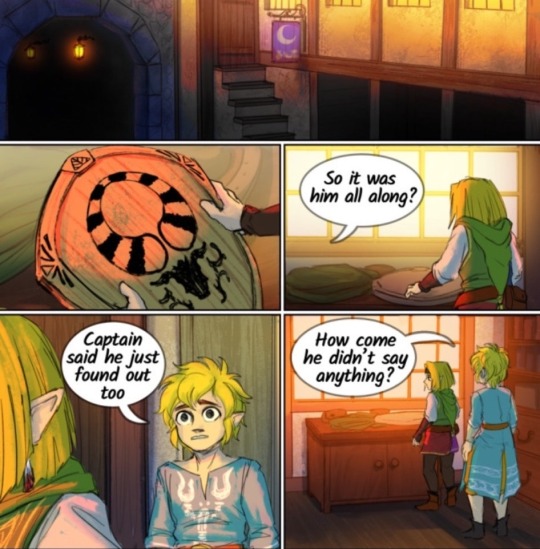
He got Twi's shield- his bags and equipment, and organized it into one place
And he was worried. He obviously found the shadow crystal while handling Twi's stuff, but his negative reactions to it were out of concern.
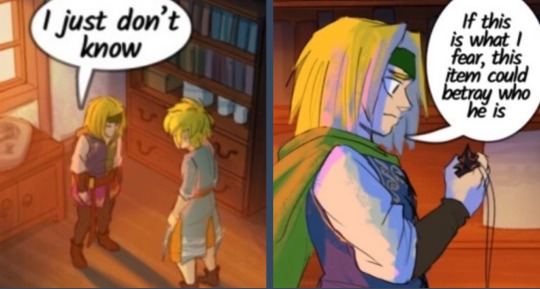
Also- because of his placement in this scene
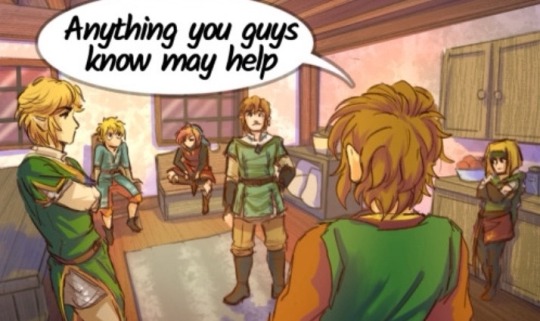
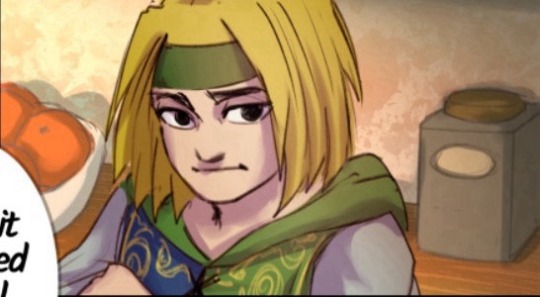
I'm fairly convinced Four was ready to start cooking before Wild showed up (since he's beside the counter with food supplies). At the very least he had the basket of fruit out for everyone -but he was literally standing with food behind him- he thought of everything
And he did housekeeping!
Wars payed for the inn, so Four took care of the inn
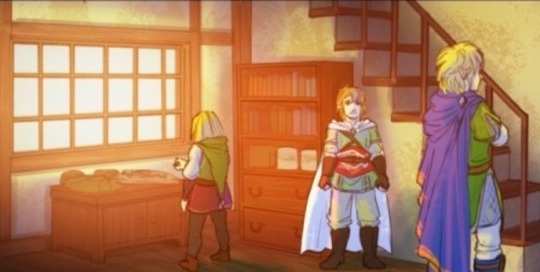
Realistically these boys were probably not too concerned with tidyness. Four got all of Twi's things on one table, and took care of the room they stayed in
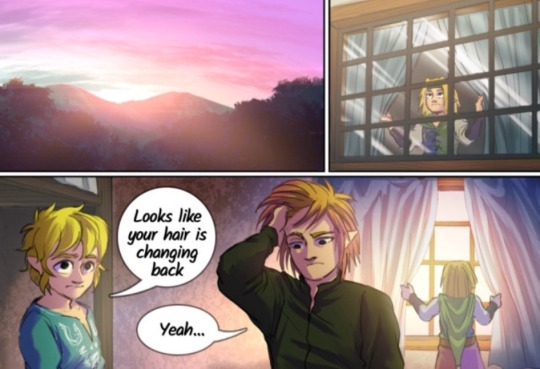
Organizing tables and Twi's things, having food supplies ready, and opening the curtains- overall he was the one tidying up the inn
Four helped in a huge way! He took care of Twi's horse (Epona is so important), his equipment and shield and bag, as well as the other rooms in the inn
Four filled in all the little tasks that others didn't think of. He helped in ways that were needed, but not obvious
There's a lot of problems with the shadow crystal and with Wild, and I don't know what's gonna happen in the future
But don't forget this- don't forget that Four was one who stepped up in an almost unnoticeable way
Don't forget that when everyone was barely holding it together, Four visited Twilight's horse and took care of his things
No matter what develops in the future- this amount of care shown is important ya know?
.
Art and comic from Jojo @linkeduniverse au :)))
#epona is so important#Lu four#linkeduniverse#linked universe#I work with horses and#Epona is INCREDIBLE- she's extremely attuned to humans and emotions. she doesn't scare easily and can keep her cool in a fight#but it's still super stressful to suddenly be in a fairly large and populated town- separated from her person#and for such an empathetic horse? Four going and TALKING to her- gently petting her nose and just being near her#means so so much! that literally matters so much to a horses mental state in a foreign situation- just having company#he checked on Epona and gave her company like !!!!!! it's so considerate and means so much for Epona! Four I love you !!!!!#uhhhh yeah!#with the food- I don't think the innkeeper would have free/complimentary food out- but wars wallet def had it covered#then wild showed up with potions in a cooking frenzy- but four was still shown with food behind him- he thought of everything#I don't know what's gonna happen with the shadow crystal and stuff. but no matter what happens in the future- this matters.#he did a ton of small things no one else thought of it matters he cares so much didjdkdksjfjj#I have a lot of posts I'm making/editing and trying to get to. I'm just a little gal trying my best :/#so many ideas and so little time... I love you guys and this fandom so much :))#(if I said anything off or offensive let me know... I'm always nervous about that but I want to hear from you if I'm wrong)#(also you are so so cool and valuable don't forget that ok? I love you and you are important)#:)
467 notes
·
View notes
Text
Unironically think that each of the bros (+April) don’t actually get how impressive their feats really are so they just do what they do and on the off chance someone comments on those feats they all react like:
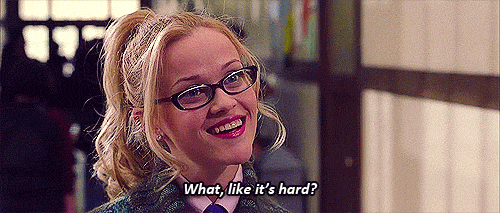
#rottmnt#tmnt#rise of the teenage mutant ninja turtles#no but really#I love thinking that they’re actually way more prideful about the stuff that does not even hold a candle to their other feats#like yeah Mikey can open a hole in the space time continuum but that’s nothing have you TRIED his manicotti??#yeah Leo has outsmarted multiple incredibly intelligent and capable people AND knows how to rewire AI but eh did you hear his one liners?#donnie accidentally made regular animatronics sentient but that was an oopsie check out his super cool hammer instead#raph was able to fake his own death to save the entirety of New York and then be the one to bring about his brothers’ inner powers-#but forget about that did you know he can punch like a BOSS?#and April can survive and THRIVE against a demonic suit of armor alongside literal weapons of destruction as a regular human-#but her crane license is where it’s really at#(not to mention all the other secondary talents and skills these kids all just sorta have like - they are VERY CAPABLE)#honorable mentions in this regard go moments like#donnie ordering around an entire legion of woodland critters to create a woodsy tech paradise#or Leo being able to avoid an entire crowd’s blind spots in plain sight#and also being able to hold a pose without moving a millimeter while covered in paint and being transported no I’m NOT OVER THAT#Mikey casually being ridiculously strong and also knowledgeable enough about building to help Donnie make the puppy paradise for Todd#Raph literally led an entire group of hardened criminals like that entire episode was just#basically they’re all so capable????#and at the same time prone to wiping out at the most inopportune of moments#love them sm
274 notes
·
View notes
Text

who am i without my powers?
#also small rant about crystalized nya because like#why did they remove her whole character development????#like call of deep was such a good episode it really resonated with me#and everything was super cool until nya got her powers back#like what????? what was the point#it literally made me so mad like srsly what was the point!!!!!#like why can't she be a ninja without her powers???#and it literally easered her entire character development throughout the seasons like why!!!!!!#and i decided i wanted to rewrite her character arc in crystalized#and this drawing is a cover for the book i'm writing :3#it'll probably be super cringe but i'll share it when i finish it!!!!!#also i can't draw water#lego ninjago#ninjago#nya ninjago#nya jiang#nya smith#art
147 notes
·
View notes
Text






2009's Dark Wolverine Vol.1 #75 cover by cover artist Leinil Francis Yu and colorist Laura Martin. Source
#Dark Wolverine#Dark Avengers#Dark Reign#Daken Akihiro#cover#Iron Patriot#Ms Marvel#Ares#Sentry#Spider-Man#Venom#process#pencils#marvel#2000s comics#claws#son of Wolverine#cool comic art#comics#Daken#Wolverine#marvel comics#The Prince#Norman Osborn#Mac Gargan#Karla Sofen#Bob Reynolds#super villains#cool cover art#tattoos
54 notes
·
View notes
Note
It was incredible Barriss being a cringe fail lesbian being like "wait, the red light saber wielding, all black wearing, Darth Vader serving inquisitors aren't here to help people?" Get her a t-shirt.
I love her so much.
IN HER DEFENCE she had been in jail and felt SUPER betrayed by the jedi so when someones like hey you were right and she's thrown an offer she can't say no to. what else is she gonna do!! and most importantly she's never done anything wrong in her life ever
#tales of the empire spoilers#TotE spoilers#thanks for the ask!#also i have watched tales of the empire now and like. idk it was decent and i liked the barriss episodes they actually felt coherent#like they had a theme going even if it wasnt super strong and it was cool seeing her again#(THO MAJOR GRIPE VISUALLY 1. her head covering and 2. i feel like her designs kinda sucked lmao. come on ur literally star wars)#the morgan eps were so meh they did not rlly convince me to care abt her story#i spent the entire first morgan ep thinking abt merrin LOL
132 notes
·
View notes
Text

Relistened n remembered the awesome song that is She Only Loves Me When I'm There ..... Lyricless ver under cut !!

#chonny jash#cj cid#covered in discontent#chonny jash covered in discontent#super epic art tag !!!!#attempted to do symbolism in some form ...#hopefully it comes across !! i thought it was cool n fun#also i NEED to listen to cid more often i overlook SO MANY tracks from there
46 notes
·
View notes
Text
I love the Land vs Air OVA with all my heart but i'm so upset that they cut most of Tora's arc from the manga. Obviousy he and Tanaka have very similar storylines with both of them being taunted by the other team/doubted as the ace but Tora's comes from the interesting perspective of the ace on a team known for it's defense. Nekoma is typically seen by their opponents as more of a unit than individual players so Tora already doesn't stand out as much as other aces. Then there's the added pressure of him being one of the few second-year aces in the series. He's got a lot to prove and playing against a tricky team like Nohebi is a great way to put that to the test.


At one point he gets overshadowed by Lev, who definetly aligns with what an ace is expected to be. He's taller, his reach is insane, his spikes are strong (when they actually make it over the net lol), and he stands out to the crowd. Then Nohebi starts targeting Tora with serves and he gets even less chances to hit. But instead of being spiteful towards Lev or falling for Nohebi's provocations Tora knows that getting the ball up is just as important as scoring points.


Even on a team like Nekoma where everyone's a fantastic reciever Tora's really kills it! He's super consistent with good aim, and when your setter's as picky as Kenma that's important. Also he's good with both underhand and overhand recieves Again, it's a similar situation to Tanaka's arc with the other team aiming their serves at him to break his spirit but I think it has it's own charm. One thing I like about Tora in general is that he's always shown a lot of admiration for recieving even if it's not the flashiest skill on the court. Think the first-year flashback when one of the first things he did was admire Yaku's perfect A-pass. Guess that's par for the course for any Nekoma player.


Then there's the moment where he bumps Lev's failed blocked and immediately goes in for the spike, AND HE LANDS IT. After all his patience he finally gets to redeem himself ughhh.


Overall I love how these few chapters show that there's more to being an ace than amazing spikes. It's consistency, it's being an amazing all-around player, it's being a reliable teammate and coming back strong when your underclassmen need you. This mini arc is a great showcase of Tora's mental fortitude— despite his looks and short-temper he's great under pressure.


This whole page is golden. From Akane's adorable little reaction to the Kenma/Tora high five to Tora immediately ruining the moment. He's so annoying.
also this panel :')

ALSO Fukutora crumb cause you know me. Anyways I love Tora Haikyuu, thanks for coming to my TedTalk.

#I know he's not a priority character and they had a lot to cover in just two episodes but man. This guy. That's my goat.#I JUST NEED PEOPLE TO LOVE HIM LIKE I DO#he's a stupid annoying loser but he's cool sometimes when Fuurudate decides to stop bullying him#also his design in the manga is so much better than the anime he's so pookie#maybe i just like the manga art style ughhhhh i could eat it for breakfast every day#i understand why this arc was just an OVA and not part of the main season but augghghh so many little details are lost#not just in this arc either a lot of characters loose their little moments to shine#I guess you gotta expect that with anime adaptations#i'm super glad Shibayama got a highlight!! he deserves that screen time#i love nekoma so much they're everything to me and more#Tanaka's season 4 arc is one of my favorite moments in the series so maybe i just like stuff like this#ant's rambling tag woo#nekoma#haikyuu#haikyuu!!#yamamoto taketora
44 notes
·
View notes
Text
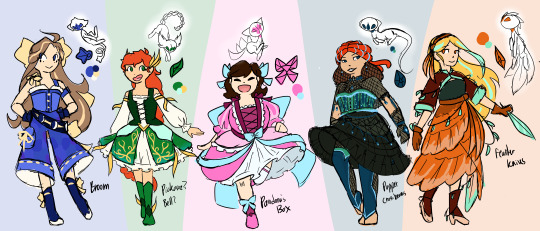
Hermitgals but its a PRISM Corps au! Because I haven't stopped thinking about it
if you don't know, PRISM Corps is a magical girl universe created by ActuallyRea/Ginjaninjaowo. I drew Pearl as a prism magical girl a while ago for a daily pearl doodle, and later Gem as well, but now here's all of them!
These are still just sketches and rough ideas of what they'd look like because I'm bad at designing clothes, but I'm pretty happy with most of them :D
Notes about the gals and their weapons under the cut :3
I know that the girls change their hair color when they transform, but for the sake of keeping them more recognizable I did keep their hair colors the same as how I would usually draw them, plus sometimes some colorful streaks. Also their hair colors just happen to go pretty well with their color schemes anyways
Pearl - Weapon: Broom, has the ability to make anything it sweeps over disappear. Objects can be resummoned at a later time and will reappear once the prism is deactivated. She's usually part of the cleanup and damage control crew. Her Prism's name is Robbie!
Gem - Weapon: Still deciding on this one! Originally I put her weapon as twin swords but I'm reconsidering it. I also slightly changed her outfit design. Suggestions are very welcome for what her weapon should be, and feel free to be as creative as possible :D Her Prism's name is Mackenzie!
Stress - Weapon: Pandora's Box. A box that contains...something. We're not sure what it is, but it's some kind of spirit that is able to possess and take control of other people. There might even be multiple spirits. She can also trap other people in the box. Her Prism's name is Mochi!
Cleo - Weapon: Puppet Crossbeams, has the ability to control inanimate objects. Is also pretty decent at wacking people. I'm the least sure about Cleo's current design, I had a lot of trouble with it and would appreciate some suggestions and feedback because I am not a Cleo watcher haha. Her Prism's name is Stheno!
False - Weapon: Feather Blades. She can pluck the feathers off of her skirt to use as blades of any length. The amount of feathers she has is pretty decent and more than enough to get her through a standard fight, but it is limited. She'll have to wait for her prism to recharge again after using all of them. This is probably my favorite concept because it is dramatic as heck. I haven't decided on her Prism's name yet, but it'll probably be some kind of bird.
Storywise, False and Cleo joined the Corps around the same time, Stress some time after, and Pearl and Gem joined together later on. Out of this lineup, False is easily the most powerful, prism-wise and skill-wise, out of all the gals here. Maybe False gets to coach Pearl and Gem or something hehe
Oh! And this isn't all of them. A prism has gone rogue and there seems to be an independent magical girl in the city as well...
#my art#hermitcraft#hermitgals#PRISM Corps#pearlescentmoon#geminitay#stressmonster101#zombiecleo#falsesymmetry#very proud of all these#like for false specifically#i just imagine that like shes in a really rough battle#and she only has a few feathers left on her skirt#(she has pants underneath dw lmao)#i really love the look of that i think its super cool#the feathers “oxidize” into the coppery green when she plucks them off#also i struggled with stress for a good while as well#mostly because initially i wanted to make a character page for her like pearl and gem#but i couldnt find a way for her to hold the box without it covering her outfit#which was actually the main motivation for drawing this lmao#anyways drop your suggestions ideas comments for the girls!#i need ideas#as someone who only watches pearl and gem adlfkjadfs
356 notes
·
View notes
Text

A whole page of doodles!
#my art#chonny jash#cccc#chonnys charming chaos compendium#cj hms#cj heart#mind cj#cccc soul#cccc heart#cccc mind#heart chonny jash#chonny jash soul#cj soul#you should go listen to the twitchydc covers on yt#super underrated and the designs are incredibly cool#mind chonny jash
35 notes
·
View notes
Text
so instead of get back into art after the basic recovery of my surgery, I instead replayed Mario and Luigi Partners in Time…and why does nobody talk about this game?? Hardly ever see it in the Super Mario tag. Like. It’s actually insane how dark it gets. People die. Like actually die. Not as dark as SPM but like we see the dead spirits of Toads get siphoned through tubes. They had their life force sucked out of them via genetically modified trees. Yoshis were eaten by a larger alien Yoshi and were gonna be turned into more alien Yoshis via a factory IN THE GIANT ALIEN YOSHI. We see a town that’s literally just “Christmas is Cancelled” the city. Their mayor probably died. We never see these places restored because there are no survivors to restore them. The citizens of Hollijolli village probably all died by the time the bros shut down the Vim factory. And also there’s the entire scene with the Star Gate. Like. Hello??
maybe I’ll stream or let’s play this game and share it here because I think. More ppl should talk about Partners in Time. I’ll say it too: I like it more than Bowser’s Inside Story. By like a LOT. That’s my ramble for the night. Ttyd day tomorrow. Yippee
#Mario and luigi partners in time#MnLPiT#Partners in time spoilers#death mention#mario and luigi#super mario#germtalks#germ talks#Not art#LISTEN EVERYBODY TALKS ABOUT SPM FOR ANGST#BUT THIS GAME IS PRETTY ANGST#especially bc the babies r in it so. The ppl who use the brooklyn bros headcanon get to work with that like.#Did their parents decide to Leave the mushroom world after the ALIEN INVASION that DESTROYED MOST THE KINGDOM#Dont even get me started on shrowser#Imagine bowser covered in grotesque purple mushrooms#Like theres HORROR THERE#and ofc elder princess shroob’s real form is. Horrific. And her BOSS THEME#AUGH#I LOVE PIT!!!#The shroobs are such cool villains and ill never forget the sickass art i saw as a kid#Of peach being infected by them or bein turned evil or smth#Idr the context i jus remember she had red eyes and a buncha tubes in her like they were filling her with chemicals#Scifi horror bs right there#Oh another thing: princess shroobs eyes act like robot eyes they flicker. Turn black. And she dies#Why is that and whybis it so COOL#and then the shroob cameo in bis?!? Thats terrifying!!!#wish theyd come back#I love u purple aliens in mario
59 notes
·
View notes
Note
cool individual . points at you

I showed my best friend your ask and I thought her response was funny so I drew it lol
She doesn’t seem to think it’s a great idea to tell me I’m cool. (She also said that you’re wrong because I’m a giant nerd)
#When I broke my nose we took a selfie first and then after that went to the hospital (priorities)#It’s a really funny photo we are both laughing so hard in it but I am also covered in blood lmao#It was 2am at the time so it’s super dark in the photo too#I’m super lucky I’m Canadian because I end up in the hospital more then I should but who cares bc it’s free#I’m just an idiot#And a bit of an adrenaline junkie#Thanks for telling me I’m cool btw!
30 notes
·
View notes
Note
tiny human shows up with a GIANT monster train following behind like a duckling. this implies spider trains are native to the devildom /j
this is real now. even before humans invented trains, this absolute monster roamed the devildom, chasing down demons on its spindly spider legs and devouring them with his needle-like train teeth. charles is MASSIVE and yet ik insists he is Just A Little Guy!!
ik: everyone this is my little friend charlie :)
everyone else, who has only ever heard tell of this in legend: WHAT THE FUCK

#answering asks#anon asks#art#obey me#tentative design for an ik from this universe bc i don't really know the monster hunter aesthetic#all i know is that i want her to have the cool scar+covering-one-eye-with-hair combo#i like to think she looks super serious and weathered and all but she's still just as silly a kid as always on the inside#jtta ik#obey me mammon#monster hunter ik
105 notes
·
View notes
Text
i was recently overcome with a horrid illness that left me delirious and in pain for days, so naturally i drew dutch and hosea. clearly the only rational thing to do.

#someone PLEASEE get them out of my head#i genuinely fell asleep last night muttering to myself about how i need to draw them more 😭#and then i had a dream where it was 1876 and i was hosea and had just met dutch#it was super evil af#i think the texas pit demon possessed me or something#the cover of the american inferno took me so long btw. insane.#i took a nap right before finishing this though and it healed me psychologically and physically....#fruit toasts cool art tag btw#rdr2#red dead redemption two#red dead redemption 2#dutch rdr2#hosea rdr2#red dead redemption#red dead#rdr2 fanart#vandermatthews#dutch van der linde#hosea matthews
65 notes
·
View notes
Text



Marvel Super Heroes Secret Wars TPB Vol.1 #1 (1992 edition) by cover artist Mike Zeck.
#Secret Wars#Mike Zeck#Doctor Doom#Captain America#Wolverine#The Thing#She-Hulk#Cyclops#Colossus#Spider-Man#Nightcrawler#Human Torch#Mister Fantastic#Thor#Iron Man#Storm#Marvel Super Heroes Secret Wars#trade paperback#1980s comics#secret wars 1984#Dr Doom#Fantastic Four#Avengers#X-Men#cool cover art#cover art#Marvel Super Heroes Secret Wars by Jim Shooter & Mike Zeck
42 notes
·
View notes
Text
Does anyone know how they recorded Ryan reynold's lines in the Deadpool movies? Like. He is wearing what seems like a real mask most of the time. Is it actually all just CGI, so they can mic him normally? Do they have him record all his lines later and do a voice over like they do for fight scene grunts? Do they actually have some fancy way to mic him while he's in the suit like that and it ends up sounding as crisp as it does? If it is the last one I NEED to know how they do that.
I've been trying to find interviews about how it works but to no success. Anyone know how?
#resisting the urge to creepily DM or @ his tumblr with this question lmao#op#ryan reynolds#deadpool movies#deadpool#I'm hoping it's the last one and there's some super cool mic technique out there I'm about to learn. or like audio post editing technique#oh god that would be so fucking cool. can u imagine. lines as well delivered as his while the actor's face is actively covered?#I feel like it has to be something in post otherwise Broadway would be doing this instead of the wig thing but idk#I NEED TO KNOW#i comment#deadpool and wolverine#deadpool & wolverine
23 notes
·
View notes